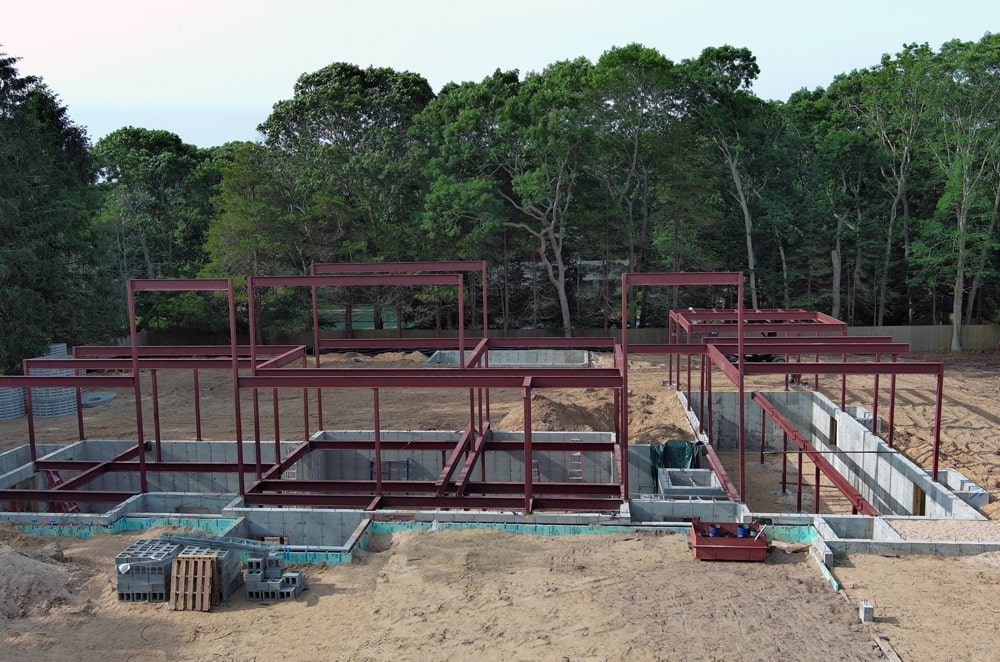Structural steel is becoming a more frequent material used in the construction of larger residential buildings. There are a wide range of structural steel members which can be used in the residential construction industry to be used for floors, roofs, walls, stairs, etc. Mid Island Steel offers a wide variety of steel shapes and types including: hot rolled plate; cold-rolled sheet; galvanized or zinc coated sheet; stainless steel; and aluminum. Each type has its own advantages and disadvantages when it comes to using them for residential building materials. Our design team can help you to design what you need and our experts in custom steel metal fabrication will create it.
Mid Island Steel, a Long Island steel fabrication company has been fabricating custom steel products and miscellaneous steel for residential steel clients for over 30 years. Mid Island Steel can help you to design your residential steel needs via SDS/2 software, or we can review your steel home architectural plans or drafts and make suggestions as to the proper columns, structural steel beams and steel fabrication solutions you will need to safely support your steel home structure.
Our metal fabrication services include both commercial building and residential structural steel fabrication services. For residential steel we can supply I-Beams, custom steel columns, custom steel flitch plates, pipe columns, header beams, metal stairs, railings and more. Mid Island Steel is an experienced steel fabricator and our residential steel fabrication services have supplied thousands of builders professional quality structural steel components on Long Island, New York.

Residential Structural Steel Fabrication
Residential Structural Steel Fabrication FAQ’s
- What are the benefits of using structural steel for residential construction over traditional building materials? Structural steel offers numerous benefits for residential construction compared to traditional materials like wood, including superior strength, durability, fire resistance, and sustainability. It allows for more open floor plans, larger windows, and higher ceilings. Additionally, steel is termite-proof, reduces construction waste, and is recyclable, making it an eco-friendly choice. Steel structures also require less maintenance and have a longer lifespan, making them a cost-effective option in the long run. Overall, the use of structural steel in residential construction provides a strong, safe, and sustainable building solution for homeowners.
- How does the process of structural steel fabrication differ for residential projects compared to commercial projects? The process of structural steel fabrication for residential projects typically involves smaller scale structures, simpler designs, and quicker fabrication times compared to commercial projects. Residential projects often focus on customization and aesthetics, with a greater emphasis on details like finishes and appearance. On the other hand, commercial projects involve larger structures, more complex designs, and longer fabrication times due to the scale and functional requirements of the buildings. Additionally, commercial projects may require more stringent quality control measures and adherence to specific regulations and standards compared to residential projects.
- What are some common challenges faced during the fabrication and installation of structural steel in residential buildings? Some common challenges faced during the fabrication and installation of structural steel in residential buildings include ensuring precise measurement and fit, handling heavy materials and equipment, coordinating with other trades on-site, managing safety protocols for working at heights, addressing potential corrosion issues, and adhering to building codes and regulations to ensure structural integrity and safety. Additionally, the logistics of transportation, crane access, and ensuring proper connections between steel members can also present challenges during the fabrication and installation process. Efficient planning and communication among all stakeholders are essential to overcoming these challenges successfully.
- How can homeowners ensure that their residential structural steel fabrication project meets building codes and safety standards? Homeowners can ensure their residential structural steel fabrication project meets building codes and safety standards by hiring a qualified structural engineer or architect to design the project. They should also work with reputable steel fabricators and contractors who adhere to industry standards and regulations. Regular inspections during the fabrication and construction process can help identify any potential issues early on, ensuring compliance with building codes and safety standards. Additionally, obtaining necessary permits and inspections from local authorities is essential to ensure the project meets all regulatory requirements.
- What are some innovative design trends in residential structural steel fabrication that are becoming popular in the industry? Some innovative design trends in residential structural steel fabrication that are gaining popularity include the use of curved or organic shapes in steel structures, incorporating sustainable materials and practices, utilizing digital fabrication technologies for precision and efficiency, and creating open floor plans and large windows to maximize natural light and views. Additionally, there is a growing interest in mixing steel with other materials such as wood or glass to create unique and visually appealing architectural designs in residential construction.